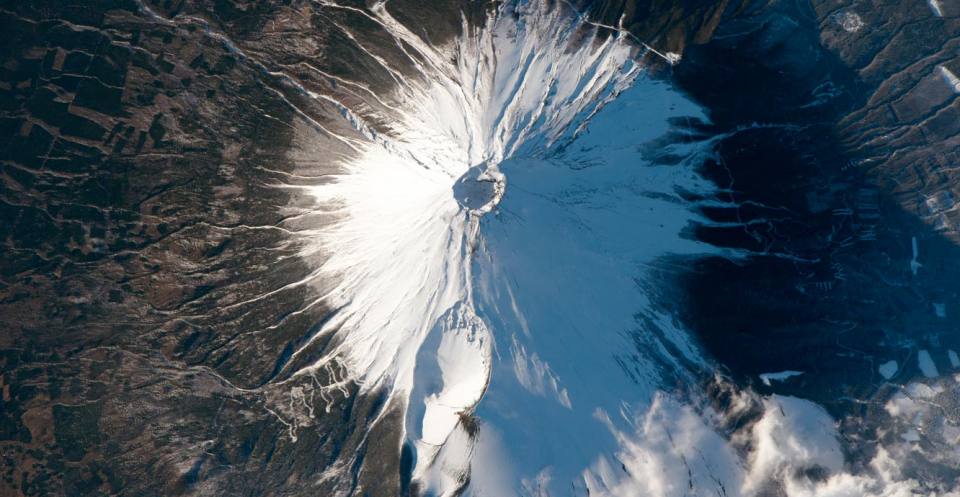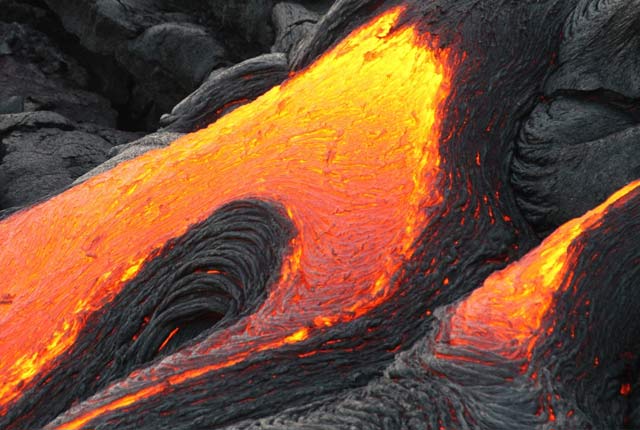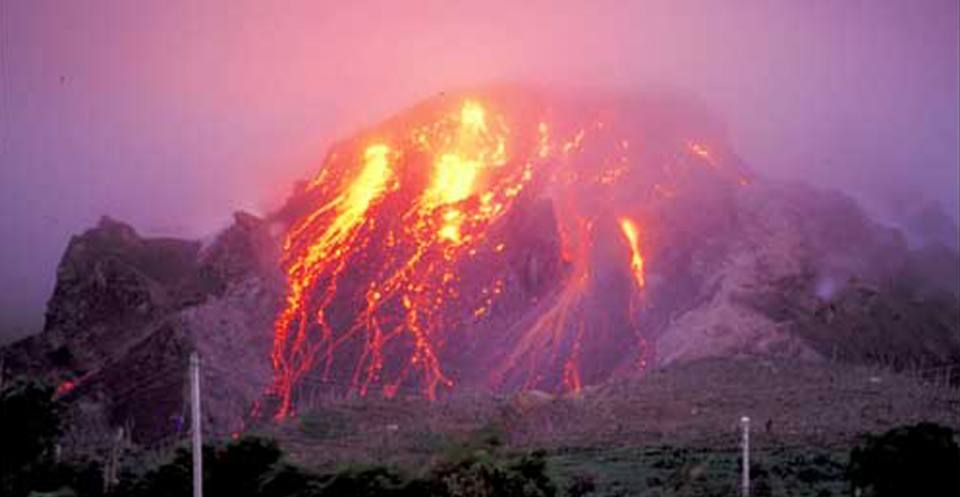When magma erupts at the surface as lava, it can form different types of volcano depending on:
- the viscosity, or stickiness, of the magma
- the amount of gas in the magma
- the composition of the magma
- the way in which the magma reached the surface
Strictly speaking there are two broad types of volcano, a stratovolcano and a shield volcano, although there are lots of different volcanic features that can form from erupted magma (such as cinder cones or lava domes) as well processes that shape volcanoes. In this section you can find out the difference between stratovolcanoes and shield volcanoes, as well as lava domes and calderas.
Why are there different types of volcano?
Viscosity is important in volcanology. An eruption of highly viscous (very sticky) magma tends to produce steep-sided volcanoes with slopes that are about 30–35°. That’s because the viscous volcanic material doesn’t flow that far from where it is erupted, so it builds up in layers forming a cone-shaped volcano known as a stratovolcano. Shield volcanoes, on the other hand, have gentle slopes that are less than 10° and erupt more fluid lavas called basalt. When a shield volcano erupts, the basalt can flow great distances away from the vent to produce broad, gentle slopes.

Cross-section of a volcano. Hot magma rises because it is less dense than the surrounding rock. Trapped gases in the magma also force it upwards. Not to scale. BGS © UKRI.
Shield volcanoes
Where a volcano produces low viscosity, runny lava, it spreads far from the source and forms a volcano with gentle slopes: a shield volcano. Most shield volcanoes are formed from fluid, basaltic lava flows. Mauna Kea and Mauna Loa are shield volcanoes. They are the world’s largest active volcanoes, rising over 9 km above the sea floor around the island of Hawai’i.

If you measure it from the sea floor, Mauna Kea on Hawai’i is the largest active volcano on Earth. Partly because of its elevation, astronomical observatories are sited at Mauna Kea’s summit. © NASA Earth Observatory.
Stratovolcano
Stratovolcanoes have relatively steep sides and are more cone-shaped than shield volcanoes. They are formed from viscous, sticky lava that does not flow easily. The lava therefore builds up around the vent forming a volcano with steep sides. Stratovolcanoes are more likely to produce explosive eruptions due to gas building up in the viscous magma.
Andesite (named after the Andes Mountains), is perhaps the most common rock type of stratovolcanoes, but stratovolcanoes also erupt a wide range of different rocks in different tectonic settings.

Stratovolcanoes, also known as composite cone volcanoes, erupt viscous lava that forms a steep-sided, triangular-shaped structure. BGS ©UKRI.

Fuji in Honshu, Japan, taken from the International Space Station. Its last known eruption was in 1708. The low afternoon sun emphasises the conical shape of the volcano. © NASA Earth Observatory.
Lava dome
The Soufrière Hills volcano, on the Caribbean island of Montserrat, is well known for its lava dome complex at the summit of the volcano, which has gone through phases of growth and collapse. As viscous lava is not very fluid, it cannot flow away from the vent easily when it is extruded. Instead it piles up on top of the vent forming a large, dome-shaped mass of material.
Caldera
Magma is stored beneath a volcano in a magma chamber. When a very large, explosive eruption occurs that empties the magma chamber, the roof of the magma chamber can collapse to form a depression or bowl with very steep walls on the surface. These are calderas and can be tens of miles across.
Calderas can also be formed during an eruption that removes the summit of a single stratovolcano. Caldera-forming eruptions can remove massive portions of a single stratovolcano. The top can literally be blown off!

Mount Tambora Volcano, Sumbawa Island, Indonesia, 2009. This satellite photo shows the summit caldera of the volcano, which is 6 km in diameter and 1.1 km deep. On April 10, 1815, Tambora produced the largest eruption in recorded history, which removed its estimated 4000 m-high peak and emptied its magma chamber. © NASA Earth Observatory
You may also be interested in

Discovering Geology
Discovering Geology introduces a range of geoscience topics to school-age students and learners of all ages.

Earth hazards
The Earth beneath our feet is constantly shifting and moving, and violently with catastrophic and immediate results. Find out more about earth hazards.

How volcanoes form
How the different types of volcano are formed and the relationship with plate tectonics.

Eruption styles
Volcanic eruptions can be explosive, sending ash, gas and magma high up into the atmosphere, or effusive, producing lava flows and domes.

Volcanic hazards
Find out about the different types of volcanic hazards that put human lives, livelihoods or infrastructure at risk of harm.

Living with volcanoes
It may seem unwise to choose to live with such a hazardous neighbour as a volcano. There are a number of reasons why people live alongside volcanoes.









